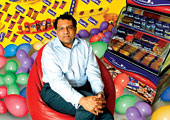 |
| Not celebrating yet: With Anand Kripalu
at helm, Cadbury wants to double its turnover by 2010 |
Ensconced
in his 2nd floor sprawling office in Cadbury House in upscale
Central Mumbai, Anand Kripalu reaches out for the bowl of candy
on the table in front of him, and picks out a Halls. The cough
drops brand is what the uk parent of Cadbury India, Cadbury Schweppes,
inherited four years ago following the global acquisition of Adams
from Pfizer Inc. Kripalu, who took over as Managing Director of
the chocolate maker's domestic operations in October 2005 (before
that he was MD for Unilever's East Africa region), is excitable
and talkative-unsurprisingly, as it is his first exclusive media
interaction since he took over the reins at Cadbury India. If
he's picked out the Halls candy-from a bowl of assorted Cadbury
goodies, including Cadbury Milk Chocolate, Perk, Five Star, Eclairs
and Gems-it's with good reason. A couple of months ago, the company
launched a new television commercial for Halls, with the slogan
'Khulke Bol', or 'Speak Freely'. "If what you want to say
is not coming out, have a Halls and speak your mind…I am
having it now to aid the process," Kripalu joked with this
correspondent last fortnight.
Kripalu's got enough to shout about from
the rooftop of Cadbury House. For one, revenues and profits have
been on a roll in 2005 and 2006 (calendar years). Over the past
two years, turnover has averaged a cumulative growth rate of 38
per cent, and the bottom line has burgeoned by 79 per cent. For
another, the company is sitting pretty in its flagship business
of chocolates with a share of a little under 72 per cent of that
pie that's valued at Rs 1,400-1,500 crore. Nearest competitor
Nestle is a distant second with a share of 24.7 per cent. Whilst
you'd expect Cadbury to lord over the Indian chocolate market-considering
it's been around in India since 1948-the significant part is that
it's regained a vital few market share points it had lost since
2004 (see The Sweet with the Sour). Even better, in the overall
Rs 2,300-crore confectionery market, Cadbury is head and shoulders
above the rest of the pack, with a share of 30.2 per cent-a 4.2
per cent gain since 2004.
Kripalu is, of course, not resting on his
oars. The sweet spot that he is in provides a perfect launching
pad to raise the bar, and chase growth aggressively. "We
would like to achieve in four years what we achieved in 50,"
he reveals. "The tailwind in the economy, coupled with more
investments, should make it possible." Cadbury has set out
to double its turnover-which stood at Rs 1,058 crore in 2006-by
2010. That shouldn't be difficult, as the company is already growing
at over 20 per cent annually. The formula for getting to Rs 2,000
crore is fairly simple: set up new capacity, and increase volumes.
 |
"We have a very
tight brand portfolio today, apart from a big focus on innovation"
Sanjay Purohit
Executive Director (Marketing) |
For his part, Kripalu will have the full backing
of the UK parent. In 2003, Cadbury de-listed from the Indian stock
exchanges, and today Cadbury Schweppes owns 98 per cent of the
shares of the Indian operations. So investments are hardly an
issue, not when Cadbury has shortlisted India as one of its battleground
markets (China, Mexico and the UK are a few other such geographies
that have been identified for sharper focus). India is the second-largest
contributor to Cadbury's Asia-Pacific revenues, after Australia/New
Zealand (which are looked at as one market), and the top brass
in the UK clearly sees potential to squeeze more growth out of
India.
Indeed for Cadbury, which already controls
over two-thirds of the chocolate pie, growing the market is an
imperative. That can happen by simply making more Indians eat
more chocolate. This calls for making it more affordable, weaning
consumers from traditional sweetmeats like barfi and rasgullas
with innovative variants, and also targeting higher-end segments,
which are currently the purview of imported brands in modern trade
(or organised retailing).
Over the past few years, Cadbury has been
attempting just that. For instance, it forayed into the 'bag product'
segment with a sweet snack, Cadbury Bytes, in 2003. Today, Bytes
is a key extension in the India portfolio. More recently, the
company launched Cadbury Dairy Milk in a tie-up with Disney (a
white and brown chocolate with Disney characters) and a new variant
of Gems (fruity flavoured), and is currently test-marketing Ulta
Perk (wafer outside, chocolate inside) in Tamil Nadu. In terms
of new price points, Cadbury, whose products begin at 50 paise,
has launched gift packs that go up to Rs 400, in a bid to attract
higher-end consumers.
The innovation is also evident in the malted
food drinks (MFD) segment, where GlaxoSmithKline is a leader by
far, with its Horlicks and Boost brands, which lord over three-
fifths of the market; Cadbury, with Bournvita, is a distant second
with a 14.8 per cent share. Sanjay Purohit, Executive Director
(Marketing), points out that the cocoa beverages segment-where
Bournvita is present-is "an exciting category". Over
the last couple of years, the company has withdrawn Delite (a
chocolate drink mix) from its portfolio, with the focus sharpening
on Bournvita. A recent extension is Bournvita 5 Star Magic, a
chocolate-caramel combination. "We have a very tight brand
portfolio today apart from a big focus on innovation where Bytes
is a good example," says Purohit.
| CADBURY IS STEPPING ON THE GAS…
|
 »
It wants to double its turnover by 2010, which
calls for a growth rate of over 20 per cent annually »
It wants to double its turnover by 2010, which
calls for a growth rate of over 20 per cent annually
» It wants
to get more people to eat more chocolate, which calls for
making it more affordable and being more innovative
» Could
get into new product categories like gums where the global
portfolio is impressive
» Aiming
for a larger footprint in the confectionery space and to be
stronger in health drinks |
| |
| …BUT THE ROAD AHEAD MAY HAVE
ITS HUMPS |
»
Large foreign brands like Hershey's have entered
the market, and local competitors like ITC are treading into
Cadbury turf
» Imported
chocolates are available via modern trade in higher-end segments
where Cadbury's presence is arguably weaker
» Cadbury
has to stick to its low price points even as input costs keep
increasing. Price hikes could erode volumes
» With
a 70 per cent market share, it's perhaps inevitable that competitors
will nibble into its share of the pie |
Needed: New Products
Brand variants are welcome, but surely what
could aid Cadbury in growing the market faster are new products
and categories-which are available in plenty with the parent.
For instance, the global portfolio includes well-established names
like Dr Pepper, which is a big player in the beverages category.
Brands like Trident and Dentyne in the chewing gum category (besides
Halls) came in through the global acquisition of Adams. "We
are not ruling out bringing in more brands from our global portfolio,
though I think we have our hands full today. Besides, India is
a Cadbury legacy market (as opposed to an Adams legacy market),"
says Kripalu. "The objective over time is to have a footprint
in the total confectionery market, apart from continuing to strengthen
our position in the health food drinks segment," sums up
Kripalu.
For the time being, though, the game plan
is clear-cut: Leverage further the Cadbury label, which is what
the company has been doing with aggressive advertising and promotions
(these costs account for 12-13 per cent of sales, with 30 per
cent of that spend being below the line). True, Cadbury is still
in many sections of Indian society almost generic for chocolates,
but it may not stay that way for long, if a clutch of high-end
brands has its way. Consider, for instance, the $5 billion global
brand Hershey's, which last fortnight inked a joint venture with
Godrej Beverages & Foods, to create a new company, Godrej
Hershey Foods & Beverages (GHFB). Hershey's will hold a 51
per cent stake in the JV. And GHFB's mandate isn't too different
from Cadbury's. "The category is too small for a country
of India's size and there is room for at least one more player.
I see the pie certainly becoming bigger over time," says
A. Mahendran, Mentor Director, GHFB.
Like most players with near-monopoly shares,
Cadbury runs the risk of losing share to new players like Hershey's,
ITC (with brands like mint-o and Candyman) as well as to premium
imported chocolates. But that may not be much of a worry if Cadbury
succeeds in growing the market. "They could, for instance,
hold a 50 per cent share but of a much larger pie," adds
Mahendran.
Another challenge for Cadbury is to maintain
its price points in an inflationary regime. For, as Kripalu points
out, a price hike could wreck the company's volumes growth, a
risk that's totally avoidable. "It's a tightrope walk,"
says Girish M. Bhat, Director (Finance & Commercial). "Cost-control
is vital, but there's no fooling around with the recipe,"
adds Kripalu. For, that would tantamount to fooling around with
growth.
|







 »
It wants to double its turnover by 2010, which
calls for a growth rate of over 20 per cent annually
»
It wants to double its turnover by 2010, which
calls for a growth rate of over 20 per cent annually